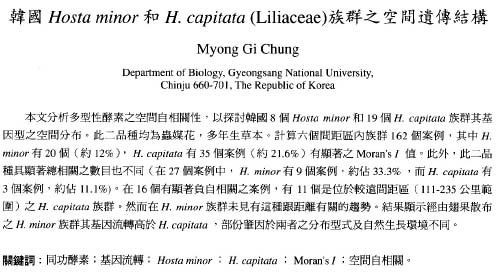Bot. Bull. Acad. Sin. (1996) 37: 25-30
Chung — Chung-Spatial genetic structure of Hosta
Spatial genetic structure among Korean populations of Hosta minor and H. capitata (Liliaceae)
Myong Gi Chung
Department of Biology, Gyeongsang National University, Chinju 660-701, The Republic of Korea
(Received May 9, 1995; Accepted October 20, 1995)
Abstract. I investigated the spatial distribution of genotypes among eight populations of Hosta minor and 19 populations of H. capitata from Korea using spatial autocorrelation analysis of enzyme polymorphisms. Both species are insect-pollinated, herbaceous perennials. Among 162 cases calculated for six distance classes among populations of both species, Moran's I was significant for 20 (12%) cases in H. minor and for 35 (21.6%) in H. capitata, respectively. In addition, the number of significant overall correlograms was different from each species (33.3%, 9/27 in H. minor vs. 11.1%, 3/27 in H. capitata). Eleven of 16 significant negative autocorrelations were observed for H. capitata in the longer distance classes (ca. 111_235 km boundary). On the other hand, no distinct trend with respect to distance was detected among populations of H. minor. The results of the study indicate that the level of gene flow among abundant, contiguous local populations of H. minor via winged seeds is higher than that of H. capitata, partly resulting from different distribution patterns and natural habitats of both species.
Keywords: Allozyme; Gene flow; Hosta capitata; H. minor; Moran's I; Spatial autocorrelation.
Introduction
Recent reviews of the plant allozyme literature have shown casual relationships between several life history and ecological traits of plants and the amount and patterns of genetic variation (e.g., Hamrick and Godt, 1989; Hamrick et al., 1992). For instance, species with narrow or endemic distributions maintain lower levels of genetic diversity than species with widespread distributions. Knowledge of geographic range, however, may not always be predictive of levels of genetic variation (Chung and Chung, 1994; Soltis and Soltis, 1991). This may be explained by the fact that species, even congeners, often differ in many other aspects of their biology. In their review of the plant allozyme literature, Hamrick and Godt (1989) included 653 taxa and classified each species for eight traits to find correlations between the traits and levels and distribution of genetic variation. Unfortunately, less than 50% of the variation among species was explained by their models, which is due to differences in the specific ecological, evolutionary history and other unknown factors among species (Hamrick et al., 1991). Spatial genetic patterns within and among populations affect the evolutionary dynamics of plant populations and species (Sokal and Oden, 1978b). An understanding of the pattern could give us a more explicit understanding of the evolutionary and ecological processes in plant species and thus has been of continued interest to evolutionary and conservation biologists (Heywood, 1991; Xie and Knowles, 1991). Spatial structure may be analyzed using spatial autocorrelation analysis (Sokal and Oden, 1978a). The analysis has only recently been applied to large scale structure on a number
of animal species (e.g., Sokal and Oden, 1978a,b; Sokal, 1988) and plant species (e.g., Jensen, 1986; Sokal et al., 1986) and to fine scale genetic structure within populations (e.g., Dewey and Heywood, 1988; Epperson and Clegg, 1988; Knowles et al., 1992). These studies have revealed several advantages of spatial autocorrelation analysis because the analysis includes all pair comparisons in samples and it makes no assumptions about the spatial scale of the structure within a population (Epperson, 1989; Heywood, 1991).
Population differentiation among plant populations is significantly associated with breeding systems (Hamrick and Godt, 1989). In other words, gene flow via pollen in plant species is one of the primary factors shaping genetic structure among populations. Hosta minor (Baker) Nakai and H. capitata (Koidz.) Nakai, are insect-pollinated, herbaceous perennials. Populations of H. minor, a Korean endemic species, are large and abundant on hillsides and grasslands in the middle eastern and southern Korean Peninsula (Chung and Kim, 1991). Flowers are visited by bees (Apis mellifera L. and A. cerana F.; Chung pers. obs.). On the other hand, H. capitata is native to South Korea (mainly in the southwestern Korean Peninsula) and southwestern Japan (Chung and Kim, 1991; Fujita, 1976). In Korea, most populations of the species are relatively small and isolated compared with other Korean hostas (Chung et al., 1991), and few pollinators (e.g., bees) were observed. Populations of H. capitata usually are found in pine-oak understories. The fruit of both species is a cylindrical capsule, with 10_30 small (3.0_5.5 mm) seeds in each capsule. Each seed is winged and dispersed by wind (Chung and Kim, 1991). Although both species are
